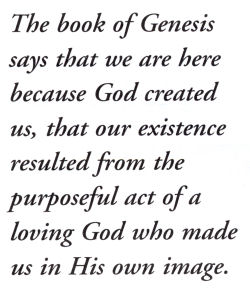INTRODUCTION
Genesis: Creation and Redemption
 In 1997 a Nobel
Prize-winning physicist made a stir when he wrote, "The more the universe
seems comprehensible, the more it seems pointless." Responding to the statement,
one astronomer wrote, "Why should it have a point? What point? It's just
a physical system; what point is there?" Another scientist, agreeing, said,
"I am willing to believe that we are flotsam and jetsam." In 1997 a Nobel
Prize-winning physicist made a stir when he wrote, "The more the universe
seems comprehensible, the more it seems pointless." Responding to the statement,
one astronomer wrote, "Why should it have a point? What point? It's just
a physical system; what point is there?" Another scientist, agreeing, said,
"I am willing to believe that we are flotsam and jetsam."
Flotsam and jetsam? Yet, considering their premise—that we are here
by pure chance alone—what other conclusion would they have drawn? After
all, we just one day are born; eventually we become aware of
ourselves—pain, fear, and hunger often being the first sensations of
self-consciousness. Uninvited, life is foisted upon us without asking for
it and yet remains difficult to give back if we don't want it and impossible
to retain if we do. We're given something none sought after, planned for,
or acquiesced in; we're not sure what it is, what it means, or even why we
have it; its most real and immediate givens—pain, sorrow, loss,
fear—remain inexplicable.
No wonder these scientists, left to try to understand our origins on their
own, see it as all pointless, a mere physical system, nothing more.
How thankful we should be, then, that the Lord hasn't left us on our own
regarding our origins. Genesis is God's revelation to us of those origins,
and it presents a view radically different from what most science presents.
That science, without revelation, has determined we're the creation of
meaningless and purposeless forces is more than enough proof of how, without
revelation, we get it all wrong.
Indeed, contrary to the "scientific" view, which says we're here only because
of pure chance, the book of Genesis says that we're here because God created
us, that our existence resulted from the purposeful act of a loving and caring
God who made human beings "in his own image, in the image of God created
he him; male and female created he them"
(Gen.
1:27). It's hard to imagine two more conflicting, irreconcilable
positions.
But Creation is only the beginning of Genesis. The book teaches us about
the Fall, the global Flood, the Tower of Babel, which together help us better
understand the nature of the world we have all found ourselves in without
any choice of our own.
Most important, though, Genesis also tells the story of Abraham and the
patriarchal line that would arise out of him, the one in whom "all the nations"
shall "be blessed"
(Gal.
3:8, RSV). Genesis doesn't focus only on the Fall and its results;
instead, scattered through its pages are symbols and shadows that point to
the great hope of salvation offered to God's fallen world through Jesus,
a hope offered to everyone who, like Abraham, claims it by faith. Or, as
Paul, steeped in Genesis, expressed it: "So then they which be of faith are
blessed with faithful Abraham"
(Gal.
3:9)--the father of "all who believe"
(Rom.
4:11, NIV).
This quarter we'll get an inspired account of the miracle that created us;
we'll also get, in hints and symbols, the earliest revelations of the miracle
that saves us: the life, death, and resurrection of Jesus Christ.
All this is found in Genesis, a book about Creation and Redemption, not "flotsam
and jetsam."
Born in Germany, the late Arthur J. Ferch immigrated to Australia, where
he worked for many years as a pastor, teacher, and administrator
Contents:
Giardina Sabbath
School Study Helps
Jerry Giardina of Pecos, Texas, assisted by his wife, Cheryl,
prepares a series of helps to accompany the Sabbath School lesson. He includes
all related scripture and most EGW quotations. Jerry has chosen the "New
King James Version" of the scriptures this quarter. It is used with permission.
The study helps are provided in three wordprocessing versions
Wordperfect; Microsoft
Word; RTF for our MAC friends (this
is now a zip file); and HTML (Web Pages).
Last updated on September 3, 2006
Editorial Office: 12501 Old Columbia Pike, Silver Spring, MD 20904.
Principal Contributor: Based on previously written work by Arthur J.
Ferch
Editor: Clifford R. Goldstein
Associate Editor: Lyndelle Brower Chiomenti
Publication Manager: Soraya Homayouni Parish
Editorial Assistant: Larie S. Gray
Pacific Press Coordinator: Paul A. Hey
Art and Design: Lars Justinen
Concept Design: Dever Design
Copyright © 2006 by the Office of the Adult Bible Study
Guide,
General Conference of Seventh-day Adventist. All Rights Reserved.
SSNET Web Site Home page
Directory of Sabbath School Bible Study
materials
Archive of previous Adult
Sabbath School Bible Study Guides
Prepared for the Internet by the SSNET Web
Team.
|